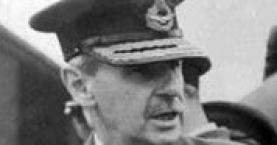
Air Chief Marshal Hugh Dowding (1882-1970) headed RAF Fighter Command during the Battle of Britain. In retirement he was actively involved in spiritualist activities, authoring several books.
Life and Career
Hugh Dowding was born in Moffat, Scotland and was educated at St Ninian’s School and Winchester College followed by the Royal Military Academy, Woolwich. He served abroad in the Royal Garrison Artillery and joined the Royal Flying Corps at the start of the First World War, becoming the commanding officer of the 16 Squadron in 1915.
During the inter-war years he rose through the RAF ranks and received awards including the Knight Commander of the Order of the Bath in 1933. In 1936 he was appointed chief of RAF Fighter Command. His promotion of radar and of the Spitfire and Hurricane fighter planes is considered to have contributed significantly to the success of the Battle of Britain. However, he was replaced in Novermber 1940, partly because of his contentious relationship with other senior officers; he retired from the RAF in 1942 and was made a peer the following year.
Dowding’s first wife died after two years of marriage in 1920. In 1951 he married Muriel Whiting. He devoted the rest of his life to spiritualism and to campaigning against vivisection.
Dowding died in 1970. He has been portrayed in films of the Battle of Britain, notably by Laurence Olivier in 1969. A statue of him stands outside St Clement Danes church on the Strand, London, and there is a memorial to him in the Calverley Gardens in Royal Tunbridge Wells.
Spiritualism
Dowding’s interest in spiritualism and postmortem survival was stimulated by grief at the death of his first wife and at the tragic death toll in two world wars.1 His first book Many Mansions (1943) is a positive survey of documented evidence tending to confirm the fact of postmortem survival. At this time, he states, he had never attended a séance or had any personal experience of spirit communications.2 In Lychgate (1945), however, he writes that he now knows ‘with complete certainty … which nothing can shake’ that he is ‘in constant personal communication with my [first] wife and other relations and friends who have gone ahead of me into the next stage of life…’3 This book gives details of ‘rescue’ work carried out by a spiritualist circle of which he was a member, with verbatim transcripts of conversations with dead servicemen being offered guidance and reassurance. His further books discuss aspects of spiritualism activities and evidence for survival.
Dowding is said to have communicated at séances following his own death,4 in one case materialising in front of the audience, moving among them, speaking and shaking hands.5
Melvyn Willin
Selected Publications
Many Mansions (1943). London: Rider & Co.
Lychgate: The Entrance to the Path (1945). London: Rider & Co.
Twelve Legions of Angels (1946). London: Jarrolds Ltd.
Earth-Lives and Astral Lives (1957). In The Great Mystery of Life Hereafter [essays anthology] by D.L. Sayers et al. London: Hodder & Stoughton.
God’s Magic: An Aspect of Spiritualism (1960). London: The Spiritualist Association of Great Britain.
Literature
Dowding, Lord (1945). Lychgate. London: Rider & Co.
Dowding (1960). God’s Magic: An Aspect of Spiritualism (1960).
London: The Spiritualist Association of Great Britain.
Dowding, Lord (1995). ‘Man is a spirit now’. Two Worlds 4213, 36-41.
Mahony, P. (1948). Out of the Silence. New York: Storm Publishers.
Paul, P. (1950). ‘Angels and fairies – but no gremlins’. Two Worlds 3269, 827.
Slee, J. (1941). ‘Banned’. Daily Herald 10 November.
Snyder, J.J. (1998). ‘Lord Dowding’s return’. Fate 581, August, 41-43.
Swaffer, H. (1999). ‘My talks with the dead’. The Ark Review 105, April-May, 31-34.

